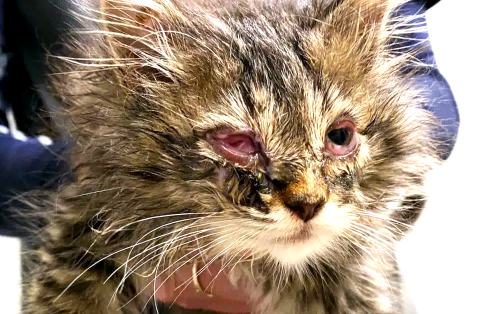
Feline herpesvirus-1 (FHV-1), also known as feline viral rhinotracheitis (FVR) is a very common virus that infects cats. It can cause a range of symptoms from mild to severe. As the virus is highly contagious, it is important for cat owners to understand the virus and how it spreads. This article will discuss whether your cat needs testing for FHV-1 and how to prevent and manage the infection.
Feline herpesvirus-1 is a double-stranded DNA virus from the Herpesviridae family. It is very similar to human herpesviruses that cause cold sores and genital herpes. FHV-1 infects the upper respiratory tract of cats. While most cats will recover from primary infection, the virus remains dormant in nerves for life and can reactivate intermittently (Gaskell et al., 2007).

Common symptoms of acute FHV-1 infection include sneezing, nasal discharge, fever, eye infections and lack of appetite. Untreated, it can sometimes lead to pneumonia. Stress is a major trigger for viral reactivation which then causes recurrent signs of nasal discharge and eye infections. Some cats may not show any clinical signs at all despite infection.
The FHV-1 virus spreads through direct contact - cats sharing food/water bowls and being groomed or played with. Queens can transmit the virus to kittens during birth. Stressful situations like boarding at a cattery or a veterinary clinic are common causes of viral reactivation in latently infected cats. The virus sheds from the eyes, nose, or skin lesions and is very stable in the environment for long periods (Thiry et al., 2009).

Yes, FHV-1 is highly contagious. Both acute infection and viral shedding during reactivation can spread the virus. Once a cat is latently infected, it will remain a carrier for life and pose a risk to other susceptible cats. Even indoor cats that do not go outside can transmit the virus if in contact with an infected cat. Stressful events predispose infected cats to shedding virus even if they are not displaying clinical signs.
While FHV-1 specifically infects cats, there is a theoretical risk of transmission between cats and humans via bites or scratches during viral shedding. However, documented infections of people are extremely rare. The main risk is to other cats that a latently infected cat may come in contact with. Proper hygiene and disinfection can minimize zoonotic risk (Gaskell et al., 2007).
Yes, our veterinary veterinary immunofluorescence quantitative analyzer FIA680/880 Vet can test for FHV-1 using the Feline Herpes Virus Antigen (FHV-Ag) test kit. A swab sample collected from the eyes, nose or throat is tested for the presence of FHV-1 antigen. A positive test confirms acute infection while a negative result does not rule out latent infection.
It is not recommended to test for FHV-1 at home as proper sample collection and handling is required. Testing should be performed by or under the guidance of a veterinarian. They will collect an eye, nasal or oral swab sample from your cat and submit it to the laboratory for analysis using an immunofluorescence assay. A test kit could also be used at a clinic with an analyzer such as the FIA680 Vet. Home testing kits are not reliable for an accurate diagnosis of FHV-1 infection.
No medication can eliminate FHV-1 once a cat is latently infected. Antiviral drugs like famciclovir or acyclovir are used to treat acute clinical signs and reduce virus shedding. They work best if started early in infection. Supportive care including fluids and antibiotics for secondary infections may be needed. Vaccination provides the best protection for preventing acute infection and reactivation. Stress reduction and isolation of shedding cats are also recommended.
To prevent the spread of FHV-1, cats should be regularly vaccinated (initially as kittens, then boosted). Only healthy cats should be boarded and stress should be minimized for infected ones. Good hygiene practices like prompt disinfection of food/water bowls and litter boxes also help prevent transmission. Identifying carriers and isolating them from other cats during viral shedding episodes is important for multi-cat households or catteries.
In conclusion, due to how common and contagious FHV-1 is for cats, testing is recommended if your cat shows any clinical signs consistent with the infection. Latently infected asymptomatic carriers can also pose a risk, especially during periods of stress. Vaccination, hygiene measures and isolation when shedding are the best ways to control spread within households and catteries.
References
Gaskell, R., Dawson, S., Radford, A., & Thiry, E. (2007). Feline herpesvirus. Veterinary Research, 38(2), 337-354.
Thiry, E., Addie, D., Belák, S., Boucraut-Baralon, C., Egberink, H., Frymus, T., ... & Lloret, A. (2009). Feline herpesvirus infection: ABCD guidelines on prevention and management. Journal of Feline Medicine and Surgery, 11(7), 547-555.